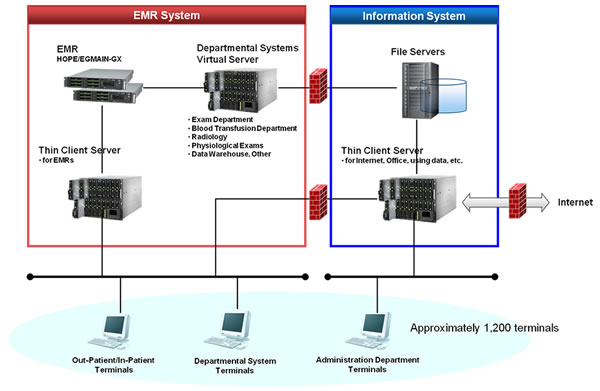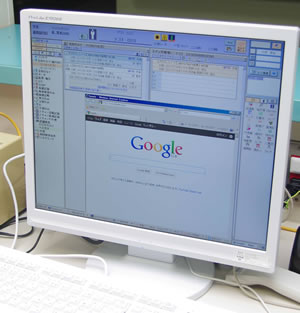Archived content
NOTE: this is an archived page and the content is likely to be out of date.
Fujitsu Upgrades Kure Medical Center's Information System with Virtualization Technology
Thin client solution enables EMR and information system to be used together
Fujitsu Limited,Kure Medical Center
Tokyo and Kure, Japan, November 24, 2011
Fujitsu Limited and the National Hospital Organization Kure Medical Center today announced that they have collaborated to completely upgrade Kure Medical Center's medical information system to a highly-secure, user-friendly thin client system using virtualization technology.
Previously, the medical information system used to manage patients' clinical data could not be used to access electronic medical records (EMR) to prevent the risk of accidentally leaking patient information. Now, through the use of a thin client system and a smart card-based single sign-on(1), Fujitsu and Kure Medical Center have built a secure, user-friendly medical information system. The new system enables the hospital's doctors and staff to securely use the Internet to conduct medical literature searches while simultaneously using the EMR system, or for example, even during patient examinations. As the new system has a built-in roaming function, hospital personnel can call up their own files from any terminal in the hospital, thereby improving workflow efficiency. Moreover, server consolidation through virtualization technology enables CO2 emissions to be reduced by 60% and, with the use of thin clients, CO2 emissions from terminals to be cut by 70%.
Issues with the Previous System
With Kure Medical Center's previous medical information system, the hospital's EMR system and information system used to access the Internet (for a web browser, e-mail, and databases used in diagnosis and treatment) were each separately managed using independent networks for security reasons. The two systems could only be accessed using separate terminals. As a result, to conduct medical searches using the Internet or to prepare documents, doctors would be required to use multiple terminals. Moreover, in managing information for any of the medical departments, including the surgery department, data entered into the EMR system would need to be re-entered into the surgery department's administrative system, making administration duplicative and cumbersome.
Features of the New System
To resolve these issues, the hospital upgraded to a new, high-security medical information system in which the EMR system and all of the applications of the information systems were implemented through client virtualization, enabling the simultaneous use of both systems through a single terminal.
 Schematic of the New Thin Client System
Schematic of the New Thin Client System
Larger View (77 KB)
1. Enables EMRs and the Internet to be viewed from the same terminal, delivering convenience and security
|
Using as its core the HOPE/EGMAIN-GX EMR system, which brings together the expertise Fujitsu has accumulated as the vendor with the highest EMR market share in Japan(2), the new system was built by linking together approximately 35 departmental systems within the hospital. To maintain security, the EMR system and the information system linked to the Internet are managed in two completely separate client virtualization environments. The two systems can be accessed through two virtual servers using a smart card-based single sign-on authorization. With this structure, the same terminal used to access EMRs can be safely used to access the Internet for e-mail or web browser functions.
Moreover, the countermeasures against leaks of EMR or other patient data have been enhanced through unified server management.
|
 Thin Client Terminal (showing EMR and web browser) Thin Client Terminal (showing EMR and web browser)
Larger View (104 KB)
|
2. Can be accessed anywhere in the hospital, meeting the needs of personnel who frequently move throughout the hospital
The new medical information system is a thin client system with a roaming user function authorized with a contact-type smart card. As doctors are frequently on the move within the hospital, roaming access helps to improve workflow efficiency. Furthermore, personnel can access their own files using the virtual server of the information system from almost anywhere in the hospital. For example, by using applications on the virtual server, hospital personnel can begin composing text while viewing an EMR in an examination room, and then easily finish the text on a separate terminal at the nursing station in the in-patient ward.
3. Reduces operational costs, improves hospital management efficiency
With the new system, the servers that needed to be configured and installed for each department in the old system have now been consolidated using virtualization technology. Operational administration for backups and other issues has now been unified. In addition to raising efficiency and reducing costs, server consolidation has reduced the space needed for server equipment by approximately 60%.
With the deployment of thin clients which have relatively low CPU load demands, system operations for terminals are expected to become more efficient, thus reducing operational costs. As EMRs and the information system can be accessed using the same terminal, the number of terminals can be reduced, thereby improving space efficiency.
4. Contributes to environmentally-friendly management
Server consolidation in departmental systems enable server CO2 emissions to be reduced by approximately 60%, and the deployment of thin clients enables CO2 emissions from terminals to be cut by approximately 70%.
Kure Medical Center will use this upgrade to its latest medical information system to deliver an even higher level of medical care, and Fujitsu will support Kure Medical Center's systems with the latest technology it has to offer.
About Fujitsu
Fujitsu is the leading Japanese information and communication technology (ICT) company offering a full range of technology products, solutions and services. Over 170,000 Fujitsu people support customers in more than 100 countries. We use our experience and the power of ICT to shape the future of society with our customers. Fujitsu Limited (TSE:6702) reported consolidated revenues of 4.5 trillion yen (US$55 billion) for the fiscal year ended March 31, 2011. For more information, please see http://www.fujitsu.com
About Kure Medical Center
The NHO Kure Medical Center (NHOKMC) has 700 beds, about 1,000 outpatients a day, 145 medical doctors, 470 nurses and 96 medical technologists, and is acting as a sophisticated medical center having inside a cancer center with research institute. Medical doctors in NHOKMC cover all diseases of infection, circulation, endo and exocrine, and cancer et al. The cancer center in the NHOKMC has been organized as a center of cancer research in the western part (Chugoku area) of Japan. For more information, please see: http://www.kure-nh.go.jp/english/index.html.
Press Contacts
Public and Investor Relations Division
Inquiries
Company:Fujitsu Limited
All other company or product names mentioned herein are trademarks or registered trademarks of their respective owners. Information provided in this press release is accurate at time of publication and is subject to change without advance notice.
This press release has been revised as of December 17, 2018.
Date: 24 November, 2011
City: Tokyo and Kure, Japan
Company:
Fujitsu Limited,
Kure Medical Center,
,
,
,
,
,
,
,
,

